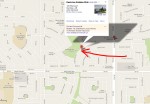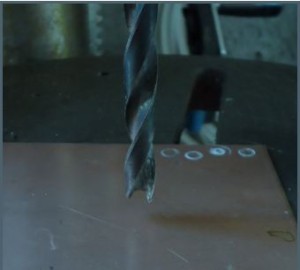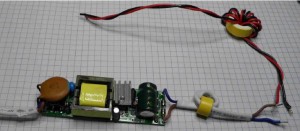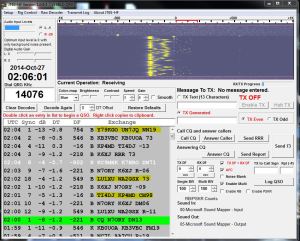- Home
- Registration
- Site Tools
- Articles
- Swap n Shop
- Contesting
- Grounding information for everyone
- History of the Central Alberta Amateur Radio Club
- CAARC owned Repeaters
- Club Repeater Info
- GMT Time Conversion Table
- VE/VA6 Incoming QSL Bureau
- Pine Lake Tornado Friday July 14, 2000.
- Amateur Radio to the Rescue
- CANWARN
- HAM Nation with Bob Heil K9EID
- Net info
- Events.
- ARES
- Links and On line study course.
- Field Day 2019
- Members D/L
- Forum/Swap and Shop

Easy prototyping of PCB boards By Earl Rubin 4Z4TJ
Jun 5th
Easy prototyping of PCB boards
Looking for a way to easily make “Manhattan†style PCB breadboards I re-discovered the “Islander†– see reference 2 below, but was unsuccessful in finding a way to purchase one. Then I found Andy Davies’ You-Tube video describing his home made land cutter. Not wanting to wait for a ¼†drill bit to break of its own accord, I sacrificed the dullest 7 mm bit in my drill box.
First I clamped the bit horizontally into…Please click the following blue link for the complete article
Easy prototyping of PCB boards

RFI considerations when converting to LED lighting By Earl Rubin 4Z4TJ
Jun 5th
RFI considerations when converting to LED lighting
By Earl Rubin, VA6TJ
I installed my new LED ceiling fixture in my shack. The light fixture consists of a flat panel of LEDs mounted in an aluminum frame that also contains a small switching power supply.. Â Before installing the new light fixture I thought it might be a good idea to check RFI on HF….
Please click the blue link below to download the complete article
WANTED
Mar 9th
WANTED 4-400 LINEAR AMP TUBE(S)FOR MY HOME BREW GROUNDED GRID LINEAR
DOUG BRADLEY VE6VY
CAARC on facebook
Dec 28th
Joint the site for information and sharing.
https://www.facebook.com/groups/117167868317864/
NEW CAARC Executive for 2014-2015
Nov 28th
The Annual General meeting of CAARC was held on Tuesday November 18th at the new Red Deer County Search and Rescue building. Ric Henderson VA6RIC ( Director of Community and Protective Services) gave everyone a tour of the new facility and equipment.
The new executive for the 2014-2015 year is as listed below.
Thanks to everyone who attended and congratulations to the new executive.
I look forward to working with you over the next year.
Bob VE6BLD
Past President – Sandy Jacobs VE6SND
President– Bob King VE6BLD
Vice President-Â Steven Lee VA6SGL
Secretary– Bill Jackson VA6BLL
Treasurer– Karen McKinney VA6LDY
Directors
- Brian Davies VE6CKC
- Neil Rowe VA6AK
- Rick Koinberg VE6RAK
- Bob Bryce VA6TRB
- Bryan McKay VE6JPW
Appointments
Repeaters
Skip MacAulay VE6BGT
Emergency Coordinator
Jeff Low VA6JL
Publicity
Geoff Norris VA6TAC
Webmaster
Bob King VE6BLD
Net Control
Bob King VE6BLD
Amateur Radio Saves the day again
Sep 22nd
Last night, Sunday September 21, 2014, at approx. 21:00hrs PST VY1MAP (Terry) called on our local repeater-146.880-looking for VY1RF (Ray).
Terry wanted Ray to make a phone call for him as he was not in cell phone range. The situation was that Terry is a member of our Search and Rescue team and they were on a search for a missing teenager. The command center they had setup was approx 35kms north of Whitehorse at Lake Laberge. The satellite phone that they were to use, was not functioning so they had no way to call for assistance, additional resources or send status reports.
That’s where amateur radio comes in. Terry, being a ham, goes out to his truck and makes contact with Whitehorse via 2M amateur radio with VY1RF (Ray) and VY1RM (Ron). They were able to pass important traffic to/from the command center.
The young man was found and all ended well.
This is the second time in as many months that amateur radio and in particular Yukon Amateur Radio Association’s members and infrastructure proved invaluable in an emergency situation. Good job guys!
Just remember-Keep calm and grab your radio!
Radioworld Central Grand Opening
Jul 9th
Dear Friends,
Everyone at GPS Central and Radioworld is thrilled to announce the “GRAND OPENING†of our new retail store “Radioworld Central†in Calgary, AB. We wish to invite you to join us in celebrating this exciting occasion on Saturday July 26th, 2014.
We have partnered with the very best manufacturers including Garmin, Lowrance, Simrad, Humminbird, MinnKota, Icom, Yaesu, Kenwood, FlexRadio, Minelab, Garrett, Uniden, Cobra, K40, Wilson Antenna, Bushnell, Celestron, Globalstar, ACR, BlueFox and many others to offer consumers the very best products, sales assistance and technical support from the most experienced staff in the industry, a core value built and proven over the past 15 years.
Radioworld Central’s focus is to provide the widest selection of products for Commuters, Travellers, Geocachers, Amateur Radio operators, Metal Detectorists, Anglers, Hunters, Hikers, Backpackers, Runners, Golfers, Bikers, Riders, Pilots, Truckers, RVers, Shortwave Radio enthusiasts, Weather enthusiasts and beyond, all at competitive pricing and service second to none. We specialize in providing smart electronics into niche markets and never stop searching for the next great product to bring to our customers.
Everyone at Radioworld and GPS Central are excited to be one team and will strive to continue to be Canada’s favourite Navigation and Communications retailer for years to come.
Please join us for the GRAND OPENING festivities and for a FREE BBQ Lunch that day!
Thank You for your support.
Angelo Meffe                                      Jack Summers                                 George Valentine
President                                            Marketing Manager                          General Manager
angelo@radioworld.ca                        jack@radioworld.ca                            gvalentine@gpscentral.ca






